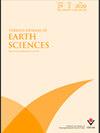Reducing uncertainty with fault seal analysis: A case study of Jherruck Block, LowerIndus Basin, Pakistan
IF 1.1
4区 地球科学
Q3 GEOSCIENCES, MULTIDISCIPLINARY
引用次数: 0
Abstract
: Faults can be either conduits or baffles for hydrocarbon flow. Assessing the sealing potential of faults plays a vital role in reducing the risks associated with hydrocarbon exploration. The study area is located in Jherruck Block, Lower Indus Basin, Pakistan. Several intervals within the Lower Goru Formation in Lower Indus Basin are proven hydrocarbon reservoirs. The main aim of the study is to predict the cause of failure of 3 wells (Jherruck B-1, Jamali-1, and Jamali Deep-1), and to propose a new well location based on juxtaposition analysis and shale gouge ratio (SGR). The Upper Sands (sandstone) of the Lower Goru Formation (A-Sand, B-Sand, C-Sand, and D-Sand) have reservoir potential in the region including the Jherruck Block. These reservoir sands have been interpreted in seismic sections to generate time and depth surface maps. Using depth surface maps, Allan diagrams have been constructed for juxtaposition and shale gouge ratio analysis. The integration between juxtaposition and shale gouge ratio analysis suggested that the main reason for the failure of these wells was sandstone to sandstone juxtapositions leading to updip hydrocarbon leakage to the adjacent fault block. In addition to this, the shale gouge ratio indicated low shale gouge distribution in the fault zones. Allan diagram and shale gouge ratio analyses helped us to propose a new well location further northwest of Jherruck B-1 well where sands are juxtaposed against impermeable shale lithology of the Goru Formation and SGR ratio is above 80%通过断层封闭性分析减少不确定性:以巴基斯坦下印度河盆地Jherruck区块为例
断层既可以是油气流动的管道,也可以是油气流动的屏障。评估断层的封闭潜力对降低油气勘探风险起着至关重要的作用。研究区位于巴基斯坦下印度河盆地Jherruck区块。下印度河盆地下Goru组的几个层段已被证实为油气储层。研究的主要目的是预测3口井(Jherruck B-1、Jamali-1和Jamali Deep-1)的失效原因,并基于并置分析和页岩泥比(SGR)提出新的井位。在包括Jherruck地块在内的该地区,下Goru组的上砂(砂岩)(a砂、b砂、c砂和d砂)具有储集潜力。这些储层砂已经在地震剖面中进行了解释,以生成时间和深度表面图。利用深度表面图,Allan图已被构建用于并置和页岩泥比分析。并置与泥泥比综合分析表明,砂岩与砂岩并置导致油气上倾渗漏至邻近断块是导致这些井失败的主要原因。此外,页岩泥比值表明断裂带内页岩泥分布较低。Allan图和页岩泥比分析帮助我们在Jherruck B-1井的西北方向提出了一个新的井位,在那里,砂岩与Goru组的不渗透页岩岩性并列,SGR比超过80%
本文章由计算机程序翻译,如有差异,请以英文原文为准。
求助全文
约1分钟内获得全文
求助全文
来源期刊

Turkish Journal of Earth Sciences
地学-地球科学综合
CiteScore
2.40
自引率
10.00%
发文量
6
审稿时长
6 months
期刊介绍:
The Turkish Journal of Earth Sciences is published electronically 6 times a year by the Scientific and Technological Research
Council of Turkey (TÜBİTAK). It is an international English-language journal for the publication of significant original recent
research in a wide spectrum of topics in the earth sciences, such as geology, structural geology, tectonics, sedimentology,
geochemistry, geochronology, paleontology, igneous and metamorphic petrology, mineralogy, biostratigraphy, geophysics,
geomorphology, paleoecology and oceanography, and mineral deposits. Contribution is open to researchers of all nationalities.
 求助内容:
求助内容: 应助结果提醒方式:
应助结果提醒方式:


